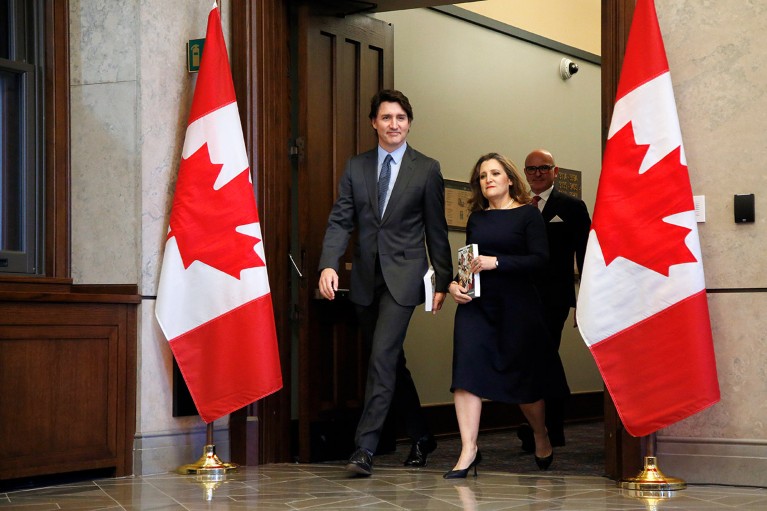[ad_1]

Canada’s prime minister Justin Trudeau and finance minister Chrystia Freeland hold copies of the 2024 federal budget.Credit: David Kawai/Bloomberg via Getty
Researchers in Canada got most of what they were hoping for in the country’s 2024 federal budget, with a big boost in postgraduate pay and more funding for research and scientific infrastructure.
“We are investing over $5 billion in Canadian brainpower,” said finance minister Chrystia Freeland in her budget speech on 16 April. “More funding for research and scholarships will help Canada attract the next generation of game-changing thinkers.”
Canadian PhD students and postgrads plan mass walkout over low pay
Postgraduate students and postdoctoral researchers have been advocating for higher pay for the past two years through a campaign called Support Our Science. They requested an increase in the value, and number, of federal government scholarships, and got more than they asked for. Stipends for master’s students will rise from Can$17,500 (US$12,700) to $27,000 per year, PhDs stipends that ranged from $20,000 to $35,000 will be set to a uniform annual $40,000 and most postdoctoral-fellowship salaries will increase from $45,000 to $70,000 per annum. The number of scholarships and fellowships provided will also rise over time, building to around 1,720 more per year after five years.
“We’re very thrilled with this significant new investment, the largest investment in graduate students and postdocs in over 21 years,” says Kaitlin Kharas, a PhD student at the University of Toronto, Canada, and executive director of Support Our Science. “It will directly support the next generation of researchers.”
Although only a small proportion of students and postdoctoral fellows receive these federal scholarships, other funders tend to use them as a guide for their own stipends.
Many postgraduates said that low pay was forcing them to consider leaving Canada to pursue their scientific career, says Kharas, so this funding should help to retain talent in the country.
“This is going to move us from a searing brain drain to a brain gain, and position us to compete on the world stage,” says Chad Gaffield, chief executive of the U15 Group of Canadian Research Universities, based in Ontario, which supported the campaign.
‘Determined to thrive’
The budget also includes marked boosts for basic research. There is an extra $1.8 billion over five years in core funding for the three federal grant-awarding research councils, as well as $400 million for upgrades to the TRIUMF particle accelerator in Vancouver, and more cash for several other large facilities and institutes across the country. There will also be more than $2 billion for the artificial-intelligence sector in Canada.
“[This budget] really emphasizes that Canada is determined to thrive in the twenty-first century based on science and research,” says Gaffield.
Canada announces new innovation agency — and it’s not modelled on DARPA
Others have pointed out that the vast majority of the money in the budget for the research councils is backloaded, with just $228 million coming in the next two years. This means that the gains will be slow, and could be vulnerable to changes in the political climate, says Alex Usher, president of Higher Education Strategy Associates, a consultancy in Toronto. “Do not count on this money being there after an election,” he posted on X (formerly Twitter). Canada’s next federal election is due in October 2025, and the opposition Conservative Party is campaigning on reigning in spending.
The budget also makes some changes to how science funding is organized. Instead of ten different programmes for scholarships and fellowships, with differing levels of support, there will now be a single programme with just three levels — master’s degrees, PhDs and postdoctoral fellowships. Kharas says that this should simplify the system.
The government will also create a new “capstone” research-funding organization to better coordinate the work of the three granting councils and “help to advance internationally collaborative, multi-disciplinary and mission-driven research”, the budget says. It will also create an advisory Council on Science and Innovation, comprised of leaders from academia, industry and the non-profit sector, which will develop a national science-and-innovation strategy to guide priority setting and increase the impact of federal investments. “This should help move us towards a more efficient, well-coordinated and nimble way of supporting research in Canada,” says Gaffield. “I look forward to working with the government to optimize it.”
[ad_2]
Source Article Link



